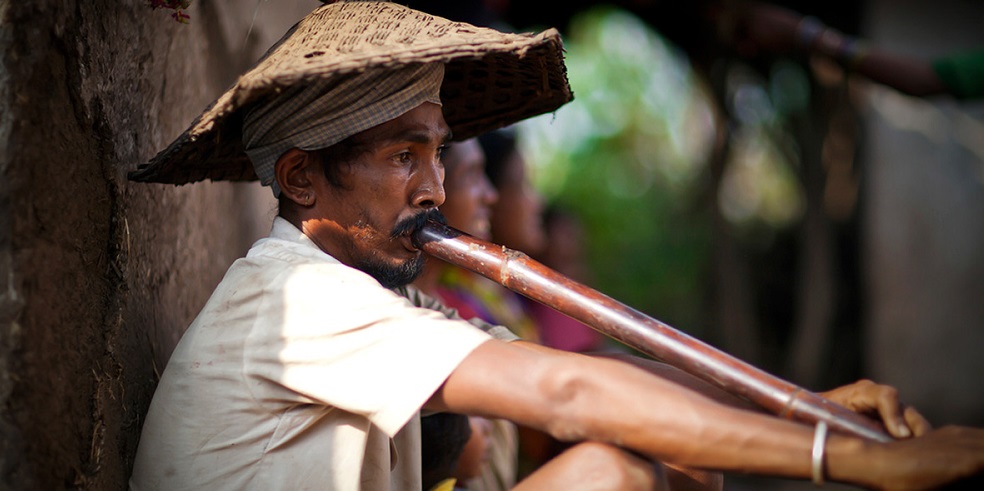Bandhavgarh National Park, nestled in the Vindhya Range of Madhya Pradesh, India, is renowned for its dense biodiversity and historical significance. It's famed as a sanctuary for the Royal Bengal Tigers, boasting the highest densities of these majestic big cats worldwide. Beyond tigers, the park is home to a diverse array of wildlife, including leopards, deer species, and several species of birds. Its ancient forts and lush forests offer not just a haven for wildlife enthusiasts but also a glimpse into India's rich cultural and natural heritage.
Two significant indigenous communities of Madhya Pradesh surround Bandhavgarh National Park - the Gonds and the Baigas. These tribes, with their rich cultural heritage and deep-rooted connection to the land, offer a fascinating glimpse into traditions that have withstood the test of time amidst the region's diverse flora and fauna. As custodians of age-old wisdom and guardians of their ancestral lands, the Gonds and Baigas contribute not only to the cultural tapestry of the region but also play a crucial role in preserving its ecological balance. Let’s delve deep to learn about their traditions, lifestyle, and the symbiotic relationship they share with the natural world around them.
The Baiga Tribe
The Baiga tribe of Madhya Pradesh first appears in historical records in a British army report from 1867 by Captain W.B. Thomson. Described as the "wildest of the tribes," they inhabited remote hills and forests, sustaining themselves through hunting with bows and arrows and cultivating small crops on hill slopes. Believed to have originated as a subgroup of the Bhumia tribe from Chota Nagpur, the Baigas traditionally lived deep in jungles, harmonizing with their natural surroundings. However, with deforestation and development, many have migrated closer to urban areas. Today, the Baiga tribe is predominantly found in Madhya Pradesh, with communities also present in Uttar Pradesh, Chhattisgarh, and Jharkhand. While their lifestyle has evolved with time, adapting to modern ways, they still preserve significant aspects of their indigenous culture. Traditional attire, worship of ancestral deities, and distinctive adornments like tattoos remain integral to their identity, reflecting a resilient connection to their heritage amid changing times.
The Baiga tribe's dance traditions are as vibrant as their cultural heritage, featuring songs that celebrate the monsoons and harvest seasons. Performers don intricate costumes adorned with grass braids, peacock feathers, and metallic anklets, complemented by elaborate headgear. Men typically play the drum known as "Mandar," hung around their necks, while women accompany the wooden instrument called "Thiski," producing rhythmic clapping sounds with its knobs. Tattooing holds a significant place in Baiga artistry and customs, with specific designs reserved for different ages and occasions. Women, in particular, display tattoos across various parts of their bodies, including their faces, reflecting deep-rooted traditions and cultural expressions within the community.
The Gond Tribe
Venturing beyond the different sections of Bandhavgarh National Park reveals a transition from dense jungle to landscapes dotted with rice fields and earthen homes. Among the local communities, the Gonds stand out with their dwellings characterized by red-tiled roofs crafted from baked clay. Surrounding their rice paddies are robust hedges designed to ward off wild animals. The Gond tribe is renowned as the largest ethnic group in Madhya Pradesh. Those in Bastar are notably isolated from the outside world due to the rugged terrain, fostering distinct cultural practices. Their traditional Madai dance is a celebration of joy. They predominantly inhabit regions along both banks of the Narmada River in Mandla, Chhindwara, Betul, and Seoni, as well as the mountainous Vindhya and Satpura ranges.
Renowned for their exquisite artwork, the Gond community has found a reliable source of income through their creative talents. Moreover, they generally enjoy better amenities compared to neighboring communities, including access to electricity. Originating as mural paintings on their mud dwellings, Gond art evolved into diverse visual forms by the early 1990s. Despite these developments, the Gond people continue to uphold ancient traditions and rituals centered around nature worship. They have distinct terms for celestial bodies such as the Sun, Moon, Stars, Milky Way, and constellations, which also serve as the foundation for their calendar and timekeeping practices.

